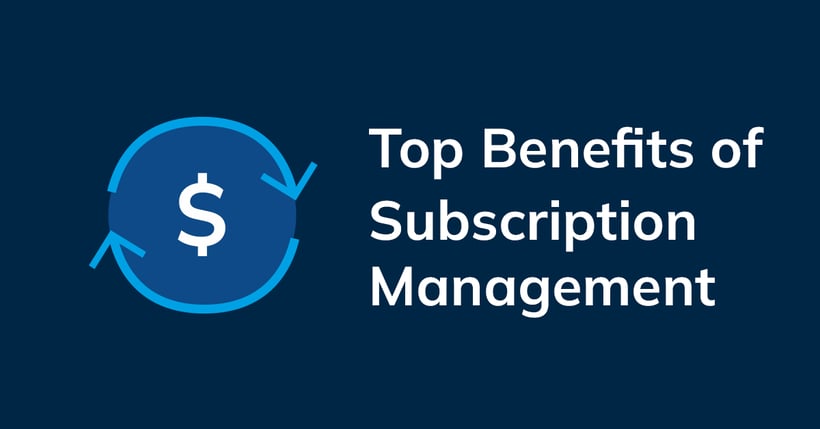Important benefits for SaaS finance teams
Subscription management involves several processes from the time your customers sign a subscription agreement until he/she terminates the contract. There are at least 9 ways the right software supports finance and accounting workflows, improves accuracy, and facilitates growth throughout the customer lifecycle.
Subscription management is the strategy, systems and processes a business puts into place to manage customer contracts and revenues. Both recurring revenues and recognized revenues are important for financial planning and management as well as company valuation.
In SaaS businesses, subscription management is challenging, complex and interesting. A customer may change their subscription several times during their relationship with a company, and each change must be handled appropriately by finance and accounting.
All this seems rather obvious, but what are the nuances of subscription management? How does it work in practice, and what role does software play?
Let’s take a look at 9 reasons subscription management is important.
Watch video: What's the easiest way to manage SaaS revenues?
1. Organize and improve revenue data
Subscription businesses rely on data from sales, customer success and other parts of the organization to correctly manage finances, yet poor data quality is one of the biggest issues for finance teams. Incorrect data leads to wrong monthly recurring revenue (MRR) and annual recurring revenue (ARR) calculations, invoicing problems and inaccurate revenue recognition. It takes hours of painstaking work to figure out the source of data problems.
Subscription management software helps SaaS businesses gather and analyze revenue data with accuracy. The software can be synched with CRM, ERP or licensing systems to make sure data is consistent in all places. Various reports and control mechanisms can also be plugged into the system to alert finance where there is missing fields or numbers that don’t meet logical values.
Analysts can also use data to understand trends and revenue opportunities by running detailed segment analysis on a variety of parameters.
2. Measure recurring revenues
Measure and reporting revenues is one of the biggest challenges of the subscription-based business model. Expected revenues changes whenever prices change, a customer upgrades or cancels their subscription or a number of other factors, making it difficult to keep forecasts and reports updated.
A subscription management solution tracks the value of each customer throughout their lifetime and automatically updates figures for reporting and consolidation. A business with 20-30 customer contracts may be able to manage the work by hand, but when the number of subscriptions gets beyond that, finance teams usually need specialized tools.
3. Improve forecasting
Subscription management tools automatically spreads revenues across the correct periods based on input data. When you are certain the amount of contracted revenue per month, quarter or year is correct, you can make qualified short-term decisions and long-term plans.
4. Optimize pricing strategies
Your company may price low to gain traction or raise prices to increase profits. Regardless of your price strategy, subscription management solutions help your finance team handle the logistics of price adjustments. The system automatically generates new invoice amounts based on revised pricing plans. Without such a system it is difficult to know which customers are impacted, what they should be invoiced and how much revenue is generated by the price adjustment.
5. Reduce churn
The first step to reducing churn is to measure it. However, measuring churn isn’t as straightforward as it might seem. How many customers are there? Has the contract been terminated or is it in a cancellation period? Subscription management systems usually include special functions that enable finance teams to keep track of complex scenarios and work proactively to increase retention.
6. Understand reasons for growth
Do you have a clear picture of change in revenue over a specific time period? Have you ever charted MRR or ARR using a waterfall diagram? Subscription management systems are good at breaking down revenue changes into the underlying element: including new sales, upsales, contraction and churn. This means finance can concisely communicate the reasons for change with the rest of the organization.
7. Proactively manage renewals
Everyone knows it’s easier to keep an existing customer than acquire a new one. That’s why so many businesses choose subscription management systems to help them track renewal dates and work proactively to successfully renew customer contracts.
A subscription management system maintains a record of renewal dates and send notification when a contract is about to expire. You can then set up the software to notify you 30, 60 or 90 days prior to renewal so you can reach out to customers to make sure they are happy. Renewal dates may also trigger price adjustments or other revenue optimizing strategies.
8. Prepare accurate financial reports
The reporting cycle can often seem overwhelming. As you grow, you may find yourself hiring contract managers, controllers or financial managers to help with the workload. A subscription management system will reduce the workload for everyone by organizing data into one central place and keeping figures organized in the right periods and reports. Having everything organized into a system can be a life saver when deadlines are approaching, and the next investor presentation is due.
9. Generate correct invoices
Customer frequently change account information, update their email, and purchase add-on services. They may also add users, increase usage-rates or make other changes that moves them up a tier in the pricing plan. When any of these events occur, invoices must reflect the changes. Subscription management software is built for purpose because they change the core billing information and either generate correct invoices or send updated information to the invoicing system.
Best in class finance teams continually adjust workflows, develop routines for data quality and automate where possible. Implementing a subscription management systems should reduce manual punching, automate processes, and improve the flow of data from capture through to reporting. In this digital world, every system should also integrate with your existing tools so you don’t have to duplicate data entry or spend hours coping with information that is spread across the business.

